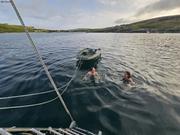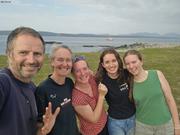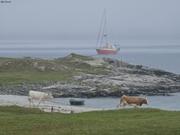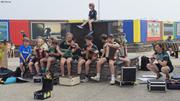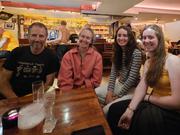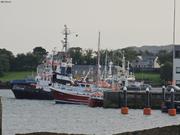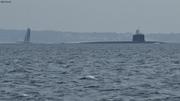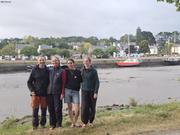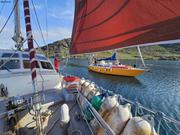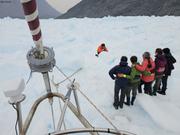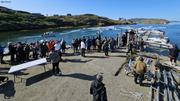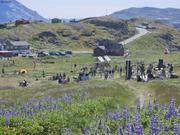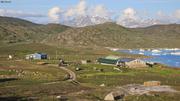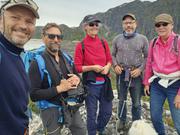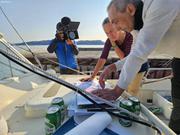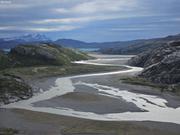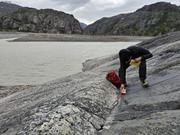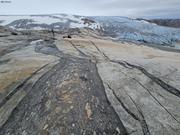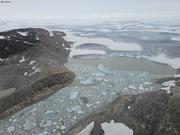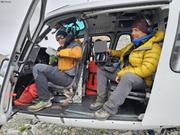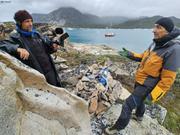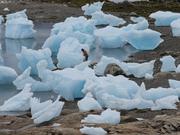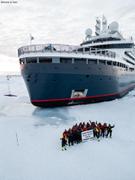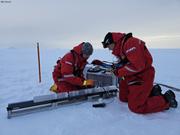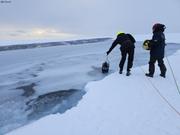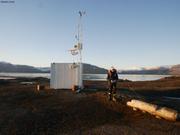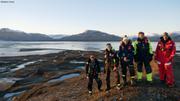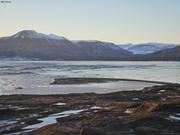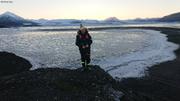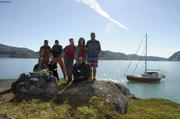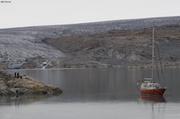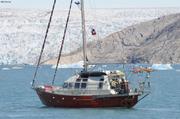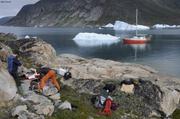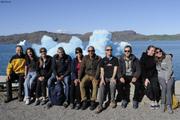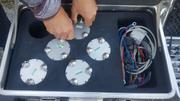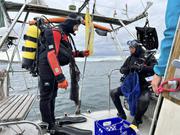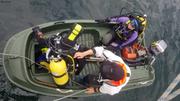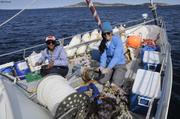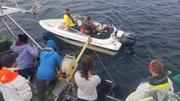Blog
From Ireland to our home
Accompanied by numerous dolphins, we drop anchor in the first small welcoming bay (Portacloy) in order to lower from the mast what remains of the scraps of our mainsail.
Then a refreshing sea bath in 13°C water relaxes us from this crossing!
The next day, we stop by our friend Mélanie’s place, always as welcoming as ever. Her crepe truck is a hit in summer, and her little house in front of the idyllic bay of Ballyconneely is open to us. The sea is warmer there, the oysters before departure are excellent, and the cows wandering on the beaches are quite a sight!
Keen to attend at least one session of Irish music — and have a pint of Guinness — in a pub, we then go down to the picturesque town of Dingle, and indeed, music is everywhere, even in a square where about fifteen young people, with their teacher, give their session!
Playing as best as we can with the weather, we still cannot pass south of Ireland in one go and must take shelter at Castletownbere, a very active and well-protected fishing port. However, as happened to us in Greenland, our anchor does not hold… We are allowed to moor at the quay, also having a problem with the helm. While waiting for this gale to pass, we enjoy the land, its trees, delicious blackberries, and one last Irish session in a very “family” pub.
When we set off again, it is for the bay of Brest! On a beautiful sea, close-hauled, suddenly the genoa halyard point breaks and it starts to descend on its own! So it is with the engines, helped by our only staysail, that we spend the last 24 hours.
Pleasure of arriving at dawn in sight of the Pointe de Saint-Mathieu. We are right on time to take advantage of the tidal currents when a call from CROSS Corsen announces that the Brest strait is “restricted,” that is, closed! No indication of time or cause… An Ultime catamaran tacks around us, a French Navy vessel asked us to deviate due to a group of divers… Fifteen minutes later, we discover the Nuclear Ballistic Submarine that was occupying the strait. Our turn! The bay of Brest is very lively in this squally weather; all kinds of boats are sailing, from windsurf boards to magnificent classic yachts, all sails out.
At the end of the bay, we enter the Faou channel, and Google Earth is useful to supplement the few channel buoys! As long as we keep one meter under the hull, it’s fine; any deviation would risk grounding! It is while stirring up the mud that we make the final turn to moor Vagabond at the pretty quay of Faou, and it is Serge Hilbert, my former director at the Douarnenez Maritime Festivals, who takes our mooring lines! Ten minutes from our home, the place is charming. We even continue to live aboard for a few days, extending the list of maintenance points for Vagabond; we are going to pamper her!
Science is done, sailing back with the family, by France Pinczon du
Aurore, Léonie, Eric and I allow ourselves a little week to stroll or explore, before setting off across the ocean back toward Brittany.
In the small bay of Kilagtoq not far from Qaqortoq, Eric takes Aurore diving near an iceberg!
Heading east, we pass by Qaqortoq again and then set course for the hot springs of Uunartoq! We could stay there for hours. Several Greenlandic families come ashore with their picnics — it’s the local recreational stop.
We then discover Nanortaliq and its surroundings under a dreamlike sun before seeking shelter far from the bulk of the forecast gale. The dramatic clouds against alpine peaks set the atmosphere, and we are happy to enter through the small pass into the wide bay of the tiny village of Tasiusaq.
However, the wind weaves its streaks of gusts there, and our anchor seems never to hold! We re-anchor at least four times, night falls, and the GPS traces our erratic drifting paths, anchor dangling at the end of 60 meters of chain… Early the next morning, while the anchor finally holds after a few hours, Vagabond’s stern is just a few meters from the rocks, and we have the leisure to enjoy the close visit of curious sheeps! When the depth sounder shows less than a meter under the hull, we set off again, chain dangling… In the end, we experience 24 hours of sliding in this bay before the calm returns and we feel as if we are on a mirror lake. We can finally stretch our legs, serenely, toward the large Tasersuaq lake at the bottom of the valley.
Before reaching Aappilattoq in the maze of the long Prince Christian Passage and its enormous cliffs, we anchor at a fjord intersection for a bivouac, comfortably settled each on our moss mattress, noses to the stars and the northern lights.
Aappilattoq and its tiny niche of peaceful water, well sheltered by high walls, finally welcomes three sailboats! We moor at a quay half the length of Vagabond, peaceful… After walking through the small, secluded village, to the sound of a calm accordionist on his doorstep, we take time to explore the weather windows to cross the Atlantic, and without delay, set off toward the exit of Prins Christian Sund. There stands an old automated and abandoned weather station, overlooking the open sea. Stunning view, letting us know it is time to go!
On the evening of August 1st, we cast off for Ireland. With the following wind, we almost made it in eight days! But from strong to very strong conditions, the crossing was punctuated by two waypoints to pick further north, recommended by our friend and router Christian Dumard, to avoid the worst… the storm still caught up with us: 24 hours from Ireland, the black clouds of the tail of a depression that had become too active destroyed our mainsail, shredded! It must be said that with the anemometer stuck between 50 and up to 65 knots, we spent 8 hours in a rather “survival” mode! But our faithful Vagabond is sturdy. More than my arms, stiff with cramps at the helm… We broke all of Vagabond’s speed records: many surfs at 11, then a memorable one at 13 knots!!! Sporty but productive.
Geology and geophysics in Gardar, opus III, part 2, by France Pinczon
July 8th, Léonie and Aurore arrive from France, barely ahead of Christophe Prunier, a geophysics engineer, Christian Schiffer, a geophysicist already on board last summer, and Christophe Raylat, director and cameraman, who takes over from Pierre Petit.
The idea is to recover the 15 seismic stations that we set up last summer in order to record the “tremors of the earth”! Joy to be reunited as a family to share this last part of the mission that has occupied us for three summers, and with such good companions!
Christian is delighted, mission accomplished: all the stations have worked. Christophe too: he is the one who had planned and packed all the necessary equipment into the blue IPEV container, stored in Narsaq for a year, and whose return by cargo he is preparing. And our Christophe “meerkat” nicknamed so by the girls’ camaraderie, stores all of this with enthusiasm in the eye of his camera.
Around a bend in a fjord, we spot a small yellow sailboat, the Harmattan, which has been looking for us. We go together to the little fjord that is dear to us in the middle of Tuttutooq Island and spend a convivial evening there. Tanguy, whom we met on board the catamaran We Explore the previous year, is leaving for the Northwest Passage with his three friends. We leave them the next day, not without slowly sailing under wind to the end of the fjord that had welcomed us so warmly in previous years.
End of the mission. We pass through the ice fjord just before Narsarsuaq to marvel one last time… We moor Vagabond to a beautiful ice floe before going to frolic on this bumpy beige-white-blue terrain as the wind rises and then blows in gusts! A somewhat hurried return on board before casting off, while Mother Nature plays one of her symphonies full of strength and beauty. Special dedication to our companions who take the plane a few hours later…
An in-between time full of encounters
Once Laurent leaves, there are only three of us left on board — Pierre, Eric and me — for 18 days, before the arrival of the next team. It is quite strange to live at this less hectic pace than usual, when missions follow one another and time always seems to be running out! But we have never spent a winter in Greenland and are happy, for once, to have time to meet people, to live more in tune with those around us.
Pierre takes advantage of it, in the manner of an impressionist reporter, to capture atmospheres, testimonies, or scenes of life — all those ingredients of reality that set the scene and will bring an extra touch of soul to his documentary.
To begin with, one unmissable date: June 21st, Greenland’s National Day and the summer solstice! On the program, among other things: a seal-hunting competition in the morning, won in 9 minutes and 15 seconds after the speedboats had set off (the second hunter returns only after 1 hour and 9 minutes!), then a giant picnic in the valley at the foot of the mountain, where fish and seals are shared and cooked on site, with an outdoor stage and live band. A Greenlandic Woodstock!
We have known Ivalo for two years. She is in charge of culture in Narsaq, and she is the one who organized the June 21st festivities. This time she suggests that we join a kaffemik almost at the end of the Ikersuaq fjord, in honor of her brother Aka’s 45th birthday, who runs the Kangerlua farm there. Having arrived the evening before, weaving between the ice (not forgetting a lovely stop for ice diving and watercolor painting on ice), we find him with his son Saamik, busy bringing down the small drone they use to gather the sheeps! Elisa, his wife, immediately invites us to share the meal. The next day, three speedboats loaded with cousins and friends, as well as a quad from neighboring farmers (from the other side of the mountain), arrive in a joyful atmosphere. Sitting on the floor or on whatever can serve as a seat in the pretty little house, laughter and conversations mix with the children’s games around a round of dishes that keep being refilled: local lamb, mattak sushi, cakes of every kind… Outside, people joke or play frisbee under the gentle summer sun. Although Vagabond is slower, Ivalo is delighted to return to Narsaq with us, accompanied by her two grand daughters and her future daughter-in-law Gigi, heavily pregnant; a geology professor in Narsaq, she appreciates the cliffs we sail past and is not short of comments, both on the job opportunities here and on the burning issue of mining in the area…
Two weeks later, we are invited to the wedding of Gigi and Nanoq, Ivalo’s son! A celebration in the small church standing on a hill in the village, before going to continue the festivities at Ivalo’s house, where we also meet her more urban family, who have come from Qaqortoq or Nuuk.
Shortly before, the church has shown us the face of tragedy. We take part, in sadness and contemplation, in the funeral of a father and his son. With his 8-year-old daughter, now in a wheelchair, the father was taking them toward Qassimiut by speedboat among the icebergs and fog, when what unfortunately happens too often happened again: the boat hit a shallow area, probably at high speed. Only the little girl was found alive the next day, shivering on the shore… For this funeral, the whole village gathers and stands together in pain.
Later, together with our friends Birgitte and Jacky, we decide to visit one of the most isolated farms in the region, Eqaluitilua, as far away as it is enclosed by its barrier of icebergs. Once at anchor, we take the time to have lunch on board before going ashore. The farmer soon comes to meet us, inviting us to come and have coffee… his mother, who has lived much of her life here and has built the farm with her husband, has already prepared a magnificent cake for our arrival! Stories of their settlement, of life through the seasons, photos, drawings, tanning… no idleness here. Jacky’s presence changes everything: in Greenland for more than 30 years, he speaks Greenlandic and, above all, has long communicated by radio with the inhabitants of this farm without ever having met them! They are now switching from sheep farming to potato growing! And just like their “neighbors” across the fjord, they would never want to live in town, in Narsaq!
In Narsaq, for years, there are also Paul and Monica, American and German, who have taken great care of Vagabond during the winter. They come on board with their dog for a few days and show us the places that are dear to them.
In Narsarsuaq, near the airport, there are Birgitte and Jacky — Danish and French (naturalized Greenlandic) — who, for three years now, have been offering us friendship and logistics, lending us their bathroom and washing machine at each stop, as well as countless moments of conviviality and epic stories — dear Jacky!
Geology in Gardar, opus III
Early in the season this year, we welcome Laurent Geoffroy for the third and last year of his research in Gardar. Will the giant dykes from this region reveal their secrets?
We're still working on a time scale... immeasurable. This question recurs every day of his short stay. Breakfasts are punctuated with diagrams showing the birth of the universe 14,000 million years ago, the birth of the solar system 4,500 million years ago, the emergence of the rocks we're sitting on here in the Gardar region 1,500 million years ago... and the appearance of Man very recently, just 0.3 million years ago. Vertiginous. Just enough to put in perspective our presence on earth as thinking homo sapiens, the unique living being capable of questioning past and future.
To go back in time, you have to take a step back. This year, Laurent chartered an helicopter for one day to observe different sites from above, but also to land on massifs close to glaciers inaccessible by boat. He could discover new dykes, these magnificent veins of magma, note their positions and their orientations and thus add pieces to the enigma of tectonics in this part of the world.
On a smaller scale, we were less fortunate: a two-days storm kept Vagabond at the dock, giving to Laurent the opportunity to survey the glacial valley north of Narsarsuaq and to make some nice findings. But a freezing rain during his week in Greenland didn't help his fieldwork. Nonetheless, we continued to survey some observation sites with Laurent, notebook and compass in hand.
On board, always ready to question in depth and immortalize with his lens, Pierre Petit, film director, is building a documentary on this research; it's another challenge to show what is easier to explain in words than in pictures! His camera doesn't go back in time... As an off track mountaineer, he adapts to the situation, patiently sketching, tracking and capturing light when it seems to speak to him.
Transarctic
From September 6 to 26, 2024, some twenty scientists boarded the icebreaker Le Commandant Charcot for a crossing of the Arctic Ocean, from Nome (Alaska) to Longyerbyen (Svalbard) via the North Pole. They responded to a call for projects from ARICE (ships and platforms of opportunity) in cooperation with the PONANT company. We were four scientific coordinators to assist these researchers.
Opportunities to reach this central region of the Arctic are very rare, but the contribution of cruise ships to polar research raises hesitations and debates (read the CNRS opinion: Opportunity-driven campaigns: Ethical partnerships for scientific research? ).
Scientific work carried out during the Transarctic focused on : - thermohaline and biogeochemical properties of the Arctic Ocean - sea ice - marine ecosystems (pelagics, sea ice and bioaerosols) - the carbon cycle - the plastisphere - ship performance and structural response - ethnographic studies of polar scientific expeditions
An international team of researchers with complementary expertises: Maurizio Azzaro, Elena Adasheva-Klein, Leticia Barbero, Indiana Bruzac, Nicolas Cassar, Federico Citterich, Fuat Dursun, Francesco Filiciotto, Caroline Guilmette, Christian Haas, Ricarda Kluge, Jan Kubiczek, Alireza Merikhi, David Pearce, Alessandro Ciro Rappazzo, Elisabeth Rosselli, Franz von Bock und Polach, Shiye Zhao, Lixin Zhu.
See photos.
Inglefieldbukta
Fifteen years after Vagabond's departure, I have the opportunity to see again Inglefield Bay. Emotions! France and I arrived in October 2004 for the first wintering. Our first daughter was born during the third wintering. And France was expecting our second daughter at the end of the fifth wintering! One day, the four of us will return to see the cradle of our family.
Geology in Gardar, opus II
Léonie, Aurore and I meet up with Eric, his crew and Vagabond in Narsarsuaq, having moved from Saint-Pierre and Miquelon. We step off our friend Hubert's Pilatus PC-12 onto the Greenland tarmac, and after a joyful evening and night on Vagabond, its super-pilots Georges and Sophie take off again with our four delighted Saint-Pierrais for a lovely return flight! Our family crew is ready to welcome the geologists.
This year is very different from summer 2023, even if Laurent Geoffroy is still the leader. The instruments to be set up on last year's well-studied terrain arrived by cargo ship in spring. The instruments? Stations equipped with seismometers, to detect the earth's internal movements, to be installed for one year on carefully studied sites, constituting a system of two transects over a hundred kilometers.
We are now in phase 2 of the investigation that begun last summer into the astonishing formation of this south of Greenland region!
As the cargo ship has dropped off the IPEV container with all the equipment in Narsaq, we converge there after each installation. Vagabond becomes heavier at each rotation when carrying 3 stations: concrete blocks and batteries are our mainstays as the equipment is loaded and unloaded! There are 15 in all. Laurent is accompanied by Christian Schiffer, a geophysicist expert with these seismometers. He is German and Danish, and lives in Sweden. The 6 of us enjoy a friendly and active atmosphere on board Vagabond!
After three weeks, all 15 stations are installed and Christian is leaving. It's time for us to welcome on board Marie and Charlie, a fine artistic team of women who have come to immerse themselves in the place and in the feelings of our daughters, in order to feed the script of their animated film project: the story of a little girl who embarks on a scientific ship with her captain father, in the Arctic...!
Laurent, always on the lookout for geological clues, takes us to the paradisiacal bay of Tasiussaq, reached after a slow progression through the luminous mist of an iceberg-laden fjord. After visiting an isolated farm, the girls go for a swim in a low-lying lake, while Laurent and Eric take a geological tour of the vast bay.
A few days before our departure by plane, leaving Vagabond wisely moored in the port of Narsaq under the watchful eye of our friends Paul and Monika, a moderate earthquake - a rare occurrence in the region - is shaking us... less than 8 days after the instruments had been installed. How wonderful!
Diving in Labrador
June 26: family, friends and music on Eric Tabarly pier... Many emotions as I leave the Saint-Pierre and Miquelon archipelago after 3 years full of encounters and discoveries. To soften this big departure, I'm accompanied by 4 friends from the French Islands: Maryline Lecourtois, Rachel Robert, Hoel Chaigne and Vincent Rinaldo. Report, by SPM la 1ère.
Despite tricky conditions (weather, remote location...), Vagabond has been pampered in recent months. The sea was rough as soon as we left the harbour, but we set off calmly. Getting our sea legs was not smooth for all of us!
Logistical stopover in St-John's in Newfounland, where we welcome on board paleoclimatologists Minoli Dias, head of the scientific program, and Natasha Leclerc, assistant and diver. They have already been on board Vagabond to collect coralline algae in Greenland and Nunavut, and it's a pleasure to be reunited for this new project after lengthy preparations (funding, logistics, permits and authorizations...).
July 3, 9pm: Vagabond docks for the night at the village of Hopedale in Labrador. Final preparations and meeting with our community contacts before heading off the next morning to the dive site 20km east of the village.
For the past 10 years, Vagabond and its crew have been collecting coralline algae for Jochen Halfar of the University of Toronto and his colleagues. This usually involves prospecting by studying maps and satellite images first, then using a camera operated from Vagabond's tender. When these searches are fruitful, I dive the site with hammer, chisel and net, usually with a teammate, to try and collect the healthiest and thickest coralline samples possible.
This year there are 4 of us, and the site is already known for record samples. For a week, Vagabond stays at anchor and one dive follows another. The water is cold, visibility sometimes quite poor, but the team is united and the collection exceeds all our ambitions: more than half a ton of coralline is brought up on deck! A considerable amount of sorting is necessary, and Minoli ends up keeping 304 kg of samples, which will be transported all the way to her laboratory in Toronto.
Minoli and Natasha leave Hopedale on July 9, heavily laden but very satisfied, while my Saint-Pierre's crew continues with me for a 4-day crossing to Greenland. Drifting ice pach is blocking the entrance to the fjords, so we have to skirt around them to the north and battle our way through the pack ice to reach the entrance to the Ikersuaq fjord. We reach Narsaq on July 14th!
Article: UTM researcher tracking 1,000 years of sea ice change in hopes of predicting future conditions.
